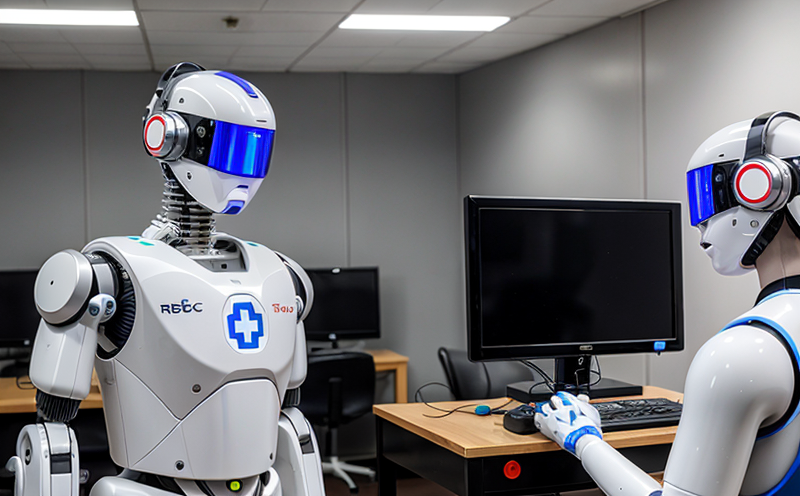ASTM F2556 Obstacle Detection Testing in Medical Robotics
The ASTM F2556 standard is a critical benchmark for the medical robotics industry, particularly focusing on obstacle detection systems. This test ensures that robotic devices used in healthcare environments can accurately detect and respond to obstacles during surgical or therapeutic procedures. The standard applies primarily to robotic arms, manipulators, and assistive devices designed to interact with human patients.
The ASTM F2556 test evaluates the performance of a robot's obstacle detection system by simulating real-world scenarios where the robot encounters various types of obstacles. These can include soft tissues, hard surfaces, or other deformable objects that might be present during medical procedures. The primary goal is to ensure that the robot can safely navigate these conditions without causing harm to the patient.
The testing process involves several key steps. First, the robotic system must be configured according to specified parameters outlined in ASTM F2556. This configuration includes setting up the robot's range of motion and defining the types of obstacles it will encounter during the test. Next, the robot is subjected to a series of predefined scenarios that simulate different surgical or therapeutic situations.
During these simulations, sensors within the robotic system must detect the presence of an obstacle accurately. The response time of the robot is also crucial; it should be able to react quickly and appropriately without overshooting or causing unintended movements that could affect patient safety. Once the test is complete, data from the sensor readings and robot behavior are analyzed using specific criteria provided in ASTM F2556.
One important aspect of this testing method is its emphasis on repeatability and consistency across multiple tests. Repeatability ensures that similar results are obtained each time the test is conducted, which is essential for quality assurance purposes. Consistency guarantees that the robotic system performs reliably under various conditions, reflecting real-world variability.
The ASTM F2556 standard also includes guidelines on how to prepare specimens used during testing. Specimens can range from simple geometric shapes representing different types of obstacles to more complex models mimicking human tissues and structures. Proper preparation ensures accurate measurement and evaluation of the robot's performance.
In conclusion, ASTM F2556 obstacle detection testing plays a vital role in ensuring that medical robots meet stringent safety standards before they are deployed in clinical settings. By adhering strictly to this standard, manufacturers can demonstrate compliance with international regulations while enhancing trust among healthcare providers and patients alike.
Scope and Methodology
The scope of ASTM F2556 obstacle detection testing encompasses the evaluation of robotic systems designed to perform tasks in close proximity to human subjects. These systems include surgical robots, rehabilitation devices, and assistive technologies intended for use within healthcare facilities. The primary focus is on assessing the accuracy and reliability of obstacle detection mechanisms.
The methodology involves several key components:
- Configuration: Setting up the robotic system according to specified parameters outlined in ASTM F2556.
- Simulation Scenarios: Creating realistic scenarios that mimic actual surgical or therapeutic procedures.
- Sensor Activation: Ensuring sensors activate correctly upon encountering obstacles.
- Data Collection: Recording all relevant data points for analysis purposes.
The testing process aims to replicate real-world conditions as closely as possible, thereby providing valuable insights into the performance capabilities of medical robots. This information is crucial for continuous improvement and innovation within the field of robotics.
By following this structured approach, laboratories specializing in ASTM F2556 obstacle detection testing can ensure consistent results across different types of robotic systems. This consistency fosters greater confidence among users regarding both product quality and operational safety.
Industry Applications
ASTM F2556 obstacle detection testing finds extensive application in various sectors, particularly those involving close interaction between robotic systems and human subjects. Some notable areas include:
- Surgical Robotics: Ensuring precise navigation around delicate tissues during minimally invasive surgeries.
- Rehabilitation Devices: Guaranteeing safe operation near patients undergoing physical therapy sessions.
These applications underscore the importance of accurate and reliable obstacle detection in maintaining patient safety and enhancing treatment efficacy. Compliance with ASTM F2556 standards is essential for manufacturers aiming to gain market acceptance and regulatory approval.
Quality and Reliability Assurance
The ASTM F2556 standard plays a pivotal role in ensuring the quality and reliability of medical robots by providing clear guidelines for obstacle detection testing. This ensures that robotic systems perform consistently across different environments and scenarios, which is paramount for patient safety.
- Consistency: Ensures that results are reproducible under varied conditions, reflecting real-world variability accurately.
- Precision: Guarantees that obstacle detection mechanisms function correctly even in challenging situations.
- Safety: Minimizes risks associated with robotic malfunctions or misinterpretations of environmental signals during critical procedures.
Compliance with ASTM F2556 helps build trust among healthcare providers, patients, and regulatory bodies. It demonstrates a commitment to excellence in product design and manufacturing practices.





